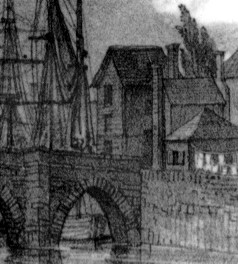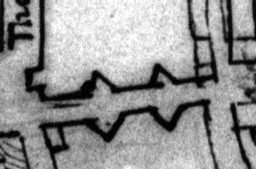This article looks at Henry Harvey’s House by the town bridge, which became an unwitting thorn in the defences of Bridgwater in 1645.

In 1638 Henry Harvey, lord of Bridgwater Castle, built a house by the River Parrett in Eastover. This sat in a narrow strip of land squeezed between the town bridge and the street now called East Quay. As he already resided in the imposing manor house he had built in the ruins of the medieval castle, this house was either to home one of his sons, to accommodate guests, or even to rent out as a tenement. It probably occupied the site of an older house or houses, as medieval towns tended to occupy every inch of space within their limits and several houses were noted as adjoining the bridge through the Borough Records.
Only seven years later this house was threatened with demolition. It was during the Wars of the Three Kingdoms (or first English Civil War) and the town was held for King Charles I against the forces of Parliament. The garrison of the town, who were busy fortifying the town with deep ditches, great earthworks and substantial forts, wished that the house be pulled down, as they feared that if Eastover was taken by the enemy and light cannon and musketeers were installed on the first floor, then they would have a commanding field of fire across the bridge and the citadel set up on the Cornhill.
Having evidently invested a great deal in this property, Harvey, after some pleading, managed to persuade them not to tear it down and the house remained standing. When the parliamentarians did come to assault Bridgwater in July 1645, the royalist garrison’s fears were realised. On 22 July a parliamentarian raiding party managed to cross the deep ditch around Eastover and breeched the ramparts, fighting their way to open the East Gate from the inside, letting their main force enter and storm the town.
The royalists retreated back over the river to Fore Street and raised a drawbridge which had replaced the central section of the town bridge. The parliamentarians quickly seized Harvey’s house and used it as an artillery platform to shell Fore Street and the Cornhill, although the returning fire from the west quickly set Eastover ablaze.
After a couple of days of exchanged artillery fire and negotiations the royalist governor of Bridgwater, Colonel Wyndham, surrendered to the parliamentarian general, Thomas Fairfax. Only two or three houses in Eastover remained standing, evidently Harvey’s house being one of them, despite receiving a sever battering. This is perhaps testament to the substantial nature of the house.
Harvey attempted in vain to get compensation from parliament to rebuild his beaten dwelling, and we do not know if he completely rebuilt it after the war or simply patched it up as best he could. John Strachey’s 1735 map of Bridgwater shows the footing of the house with its small garden plot.By the end of the eighteenth century the house appears to have been divided into three separate tenements.

John Inigo Richards depicted the house when he painted the town bridge sometime in the second half of the eighteenth century, which can be seen here.
John Chubb of Bridgwater followed Richards and drew the house sometimes in the 1790s (as shown at the top of the page), in his first depiction of the town bridge. Chubb’s was painting at a time when the area around the bridge was gradually cleared of houses, which is evident on his later two drawings, which show old Harvey’s house to have been removed.
The house of three tenements were purchased under the Act to demolish the old medieval bridge, as the approach to the new iron bridge would be wider. The foundations presumably lie beneath the pavement to this day.

References
Great Victories Sir Thomas Fairfax’s taking of Bridgwater, and the Castle, and all their works and holds therein. 22nd July 1645
Sir Thomas Fairfax’s ENTERING Bridgwater by Storming on Monday Last, July 25th 1645
Both these items may be found on Early English Books Online.
Somerset Heritage Centre D/B/bw/CL/81
Brian J. Murless, Bridgwater Docks and the River Parrett (1989)
MKP
